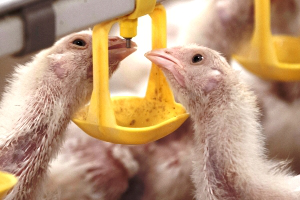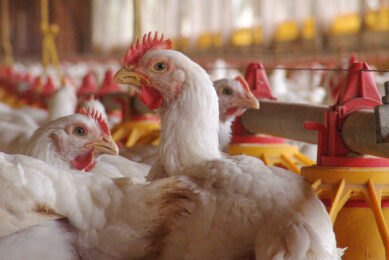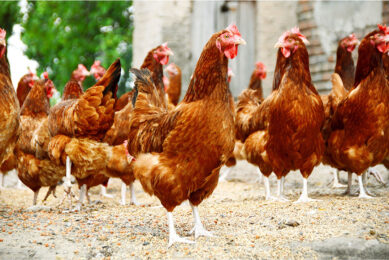Enhancing poultry performance with nutritional supplements

Successful poultry rearing and feeding is an intensive task. At every level, the requisite managerial and technical skills continually need updating. For every flock batch, attention is paid to the provision of diets well balanced in essential nutrients and fortified with additives for efficient utilisation. Here the use of nutritional supplements outside of feed rations to aid technical and economic performance of poultry is considered.
By Olayinka Akinde
After effective feed formulation and mixing, poultry managers still need to appreciate that wholesome nutrition is not exclusive to diets. Dietary feed supplements are the extra nutritional materials which are provided outside of the diets, mainly via water or other delivery methods. The reason for applying these to the diet could be nutritional, physiological, managerial or for health and profitability issues.
Water the white gold
Water is considered the most crucial nutrient required for maintenance and performance, but its perceived simplicity often makes it neglected. All reactions in the body take place in the aqueous medium. For every unit weight of feeds ingested, roughly double is taken as water by poultry. Water offers a very practical, easy and flexible route for mass delivery of soluble essential nutrients. This uniqueness facilitates the deployment of soluble nutrient supplements as an intervention strategy when birds become sick. Another attribute making water suitable to deliver nutrients is that, when birds are sick, feed intake is down regulated while water intake is up regulated. Thus managers need to select cost effective in-water nutritional supplements with proven efficacy to promote animal performance.
Stress and disease
When animals are disturbed by maladies or stress, as is often the case in practical farms, a clear signal is depression in feed intake. As feed intake drops, further degeneration is seen in production performance, feed utilisation, weakened immunity or spike in diseases like dysbacteriosis coccidiosis, enteritis and mortality. Thermal stress is a typical example. Figure 1 shows that heat distressed broilers may cut feed ingestion by as much as 10% on average for every 5ºC elevation in temperature. On the other hand water intake accelerates by 7% for every 1ºC addition to 21ºC ambient temperature. Frequently, stress agents don’t walk alone. They surface in lethal combinations with multiplier effects. Again exemplifying with heat, stress is exacerbated when there is a mix of high, variable or cyclic temperature plus elevated humidity. In tropical and subtropical regions, areas where the greatest growth in poultry production is forecasted for the coming decades, this is clearly observed.
Address disturbances
Figure 2 shows temperature and humidity figures across 2001 to 2004 from a location on a West African Savanna. Variation in monthly temp form an ‘S’ shape, meandering from 34ºC to 37ºC down to 29ºC and up to 35ºC for January to March vs August to December, respectively. The average four year data for relative humidity is presented, forming an arc shape trending to minimum of 70%/month at most times of the year. These figures are way beyond the 20-24ºC and 50% relative humidity representing practical targets for optimum poultry performance. The situation is worsened by the use of rudimentary open sided poultry areas typical in these areas. These explain why chronic heat prostration, stress and diseases eat away at the profit of the operators. They further underscore the need for more cost effective and efficacious nutrient supplements to address the disturbances.
Crucial points
Apart from direct effects of pathogens, current loads of sophisticated but routine rearing operations also burden birds into stress and immune-stimulation, costing crucial points in feed conversion. Table 1 shows some of these standard operations. As necessary as they are, they might also partly explain why performance objectives stipulated by poultry breeder companies are often difficult to realise in practical farms. Recent feed ingredient cost volatility is leaving nutritionists with fewer options but to use higher levels of cheap by-product feedstuffs (Table 2). Though feed cost is somewhat controlled, in the long run it may lead to higher incidence of gut issues like dysbacteriosis, wet litter and pododermatitis. Using feed supplements to cushion some of these effects becomes very critical not only to animal recovery but to final performance results.
Food safety
Connected to stress and disease is food safety, now a strong driver of sustainable poultry. Food safety concerns with its direct or indirect consequences (Salmonella, Listeria, E. coli, Avian Infl uenza) cause serious economic losses and can wipe out entire poultry sectors, anywhere. Especially, when there is a widespread absence of dedicated safeguards. Operations are no longer gauged solely on what is produced. Product output must be competently assured as safe to both consumers and the environment. Complicating it further is that the days of excessive usage of antibiotics to cover up management and nutritional faults are over. At each producer’s end, action must be taken to address these topics. Optimum nutrition using supplements
can be dedicated in the struggles against farm pathogens. Compliment nutrients that support robust development of birds should be within the knowledge base of all managers. It is interesting to note the accumulating scientific c data, proving that certain feedstuff s have immune modulatory and pharmacological benefits. These are now being approved and applied as nutraceuticals to pre-empt or combat microbial risks. Also useful are anti-oxidant formulations (vitamins A, C, E, etc) promoting not only in vivo, but also post mortem benefits to guarantee quality and safe eggs and meat.
Releasing potential
Modern birds are such egg and meat machines. In the last five decades, meat yield has increased five fold and breast yield over 72%. Every year the FCR has a potential to improve by 1% in broilers. For turkeys, feed efficiency to 11 kg body weight and carcass yield has improved by 50% and 6.5% respectively between 1966 and 2003. Dramatic advances are also evident for commercial hens such that by year 2020 we can expect 500 eggs/bird within a 100 week laying circle (ISA breeders). Capturing all these genetic gains under real farm conditions is doubtful without optimal nutrition. Optimum nutrition in today’s context includes provision of nutritional supplements in addition to classical feed formula.
Poultry welfare
Welfare of poultry is also becoming a marketing issue, leveraging product differentiation and thus profitability. Even in regions where this is not so appreciated, effective managers can use it to be ahead of competition. And such steps are rewarding as consumers and governments everywhere are having more say in the production chain. Nutritional supplements offer tools to protect birds from health troubles and management challenges such as crowding, transportation, stress of slaughter, etc. In the EU, 2012 is the year that all layers moved to enriched cages or non-cage systems. This is expected to impact nutrient requirements. Maintenance calorie for example will increase between 10-15% (deep litter or free range system) relative to cage system. Adapting birds to these conditions includes the feeding of supplements. The same applies to moulting without feed deprivation, which is a welfare issue.
Promoting bioavailability
Bioavailability refers to the degree of nutrient release for metabolic processes. Many times feed components interact with the animal biology in ways that either promote or hinder nutrient bioavailability. A common example is the limitation on phosphorus and calcium bioavailability due to plant intrinsic factors like phytic acid. Various supplements of these minerals are thus offered to prevent or alleviate potential deficiencies. Arguably some nutrients when applied via water are physiologically more suitable since they are already aqueous and more concentrated than in solid feeds. These help guarantee better efficacy and dosage control. Certain vitamins like B12 and Folic acid are known to be better absorbed in this way. Another option may be via injection, but that is when birds completely go off feed and obviously this method does not lend itself for routine application. A noted fact is that certain nutrients lose their activity or efficacy in the feed matrix. These include vitamins, minerals and enzymes especially when combined in premixes. Feed treatments also limit the recovery rate and efficacy of live feed microbials, with one exception being Baccilus spores. Cutting around some of these issues may mean devising nutrient solutions as supplements to be applied via extra feed routes.
Specificity and nutrient targeting
In most cases, a specific nutrient is used to target a physiological response. In other cases, we are interested in feeding specific organs or body systems for a particular benefit. For example, it is becoming common place to selectively feed the liver, kidneys or immune system or we propose to deliver some active ingredient to impact the intestinal microbial ecosytem, such as promoting lactic acid bacteria population. But feeding such things might elicit some undesirable side interactions with other dietary nutrients or materials. Obtaining sufficient slack space within the feed formulation matrix is another challenge here. A way out may be to offer them as supplements provided that efficacy is not hindered. Nutrient targeting also has economic advantages as practical and controlled studies show that overall veterinary cost is reduced by such treatments. Clearly one may project that the future of nutrition will be intertwined with health. Particularly, to achieve minimal medication, environmental protection and cost reduction and a host of other issues.
Speed and flexibility
Modern poultry demands versatility and time response to issues. Challenges during rearing may be as common place as non-specific wet litter, or occasional as acute enteritis or clinical mycotoxicosis. Depending on severity and potential impact, managers need to anticipate issues and pre-arm themselves with flexible solutions. Again this is normally difficult to do with feed. One can imagine that changing feed formulation abruptly is neither feasible nor practical in today’s regimented management systems. On the other hand with a feed supplement going via water, one can rush limiting nutrients to birds and effect changes in just one swing of action. Speed and flexibility are also crucial due to the unpredictability of issues in poultry flocks. The challenge of bioclimatology (aspects discussed under heat stress) on poultry is becoming more sporadic and unpredictable. Erratic weather especially during harvest continually causes mycotoxin concerns worldwide. All of these need to be pre-empted and prepared for in HACCP programmes. Climate changes will affect the way we feed and rear poultry in the many years to come, and feed supplements are part of the solution. In conclusion, the time of excessive reliance on feed formulation is over. Multi-faceted issues confronting poultry today demands the use of nutrient supplements to further optimise nutrition. Managers should devote ample time to gain information on available feed supplements for an effective response. With dietary supplements managers can react flexibly, timely and cost effectively to boost bird performance. Moreover these applications have significant roles to play to compensate for the adjustments demanded by consumers and regulators.
References are available on request
 Beheer
Beheer








 WP Admin
WP Admin  Bewerk bericht
Bewerk bericht